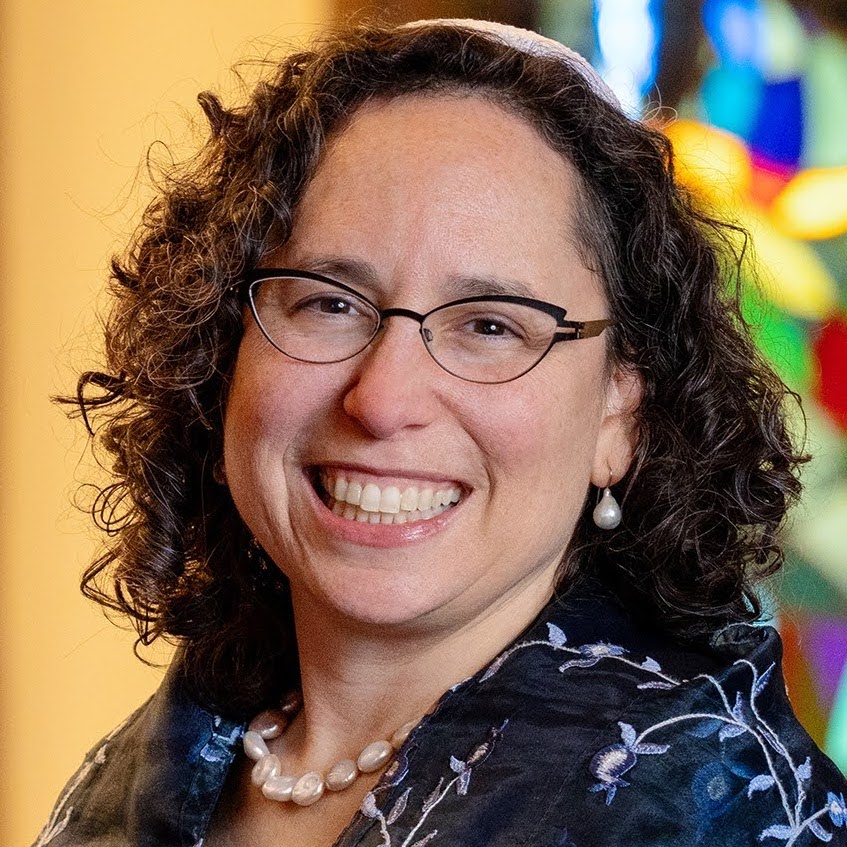(Tazria-Metzorah): Sermon for Yom Ha’atzmaut
Rabbi Julie’s sermon for Yom Ha’atzmaut (Parshat Tazria-Metzorah), May 3, 2025
This past Wednesday night, if you weren’t celebrating Yom Ha’atzmaut at the rabbis’ house, you were missing out. The celebratory vibe started when you parked your car a few blocks away and then entered a shuk-inspired party in honor of Israel’s 77th birthday. It’s hard to describe how Suzanna Grobman transformed the space with burlap bags of dried fruits and nuts complete with the metal scoops and hand-written Hebrew signs you’d find in the market stalls of Machaneh Yehudah in Jerusalem. Every imaginable flavor of Bamba and Bisli were available to be washed down with Prigat juice blends or Goldstar, ‘Israel’s finest beer’, which one enthusiast described as ‘actually not that bad.’ And if you could squeeze past the crowd, to take a closer look, you could see an amazing collection of Rachel Kanter’s vintage Israeli memorabilia; my favorites were the iconic blue and white Kibbutz hat and a poster showing an embrace between an American tourist and an Israeli Sabra.
* * *
Meanwhile, in Israel this year, there were “fires instead of fireworks” on Yom Ha’atzmaut. Suspected arson started wildfires sweeping through the hills outside of Jerusalem. Hundreds of Israeli firefighters aided by firefighting planes flown in from Greece, Cyprus, Croatia and Italy, worked tirelessly to contain the blaze. According to reporter Judah Ari Gross in E-Jewish Philanthropy, nearly 5,000 acres of forest have been burned. Though the fires were contained in the outskirts of Jerusalem, the impact was felt throughout the country as the official Yom Ha’atzmaut torch-lighting ceremony was called off and many street parties in cities and towns across the country were canceled because the firefighting teams that were needed to ensure their safety were busy fighting the wildfires in Jerusalem.[1]
In my beautiful backyard garden, a fire crackled in the fire pit adding to the ambiance of a beautiful warm night under the stars, singing with Rabbi Yosef Goldman nostalgic Israeli songs. There was something magical in the air – a feeling of peacefulness and hope, as people remembered being in Israel when a famous song first aired on the radio or still singing it at summer camp years later. We sang, outside, under a darkened sky illuminated by the lights of the pergola and the fire in the firepit, Al kol eleh, al kol eleh Shmor na li, Eli ha-tov – with all of this, please, guard for me, my God, the good. With the honey and the sting, the bitter and the sweet, please, guard for me, the good.
* * *
There’s a ritual in this week’s Torah portion that I think about every year at this time. In Parshat Tazria-Metzorah, the Torah describes in great detail the symptoms of various skin afflictions that can erupt on the body as well as the impurities that can spread over the walls of one’s house. Amidst the scaly white skin and inflammation, the discoloration and the scarring, there is close examination and separation, purity and impurity, and then after a period outside of the camp, there is return.
After healing has occurred, there is a ritual involving “shnei tzipporim chayot t’horot”, two pure living birds. The priest takes these two birds, along with cedar wood, crimson stuff, and hyssop. The priest orders one of the birds to be slaughtered over fresh water in an earthen vessel. And then the other bird, the one that is still alive, along with the cedar wood, the crimson stuff, and the hyssop is dipped in the blood of the bird that was slaughtered over the fresh water. [2]
* * *
“But the wildfires are only one part of what [set] this Yom Ha’atzmaut apart”, reports Judah Ari Gross. “Israel is still at war, and 59 hostages remain in captivity in Gaza. Many in Israel – particularly released hostages and the families of those still being held captive – called for the country to forego its usual celebration.”… In the words of released hostage Yarden Bibas, “I cannot celebrate my independence because I have brothers and sisters who are still being held hostage and my heart is still there with them. I will not be able to heal or rest until they return.” The father of Kfir and Ariel, the wife of Shiri, said how can we celebrate when the words of the Israeli national anthem “liyot am chofshi b’artzeinu’ – to be a free people in our land – are not at this moment true. Please, Yarden pleaded, “let the words ‘to be a free people in our land’ come true for everyone.”[3]
And if that isn’t heartbreaking enough, I also learned from Judah Ari Gross about a subtle but devastating change in the annual ceremony hosted by the president honoring 120 outstanding soldiers each year. Despite the fires, the ceremony took place as usual at the President’s house in Jerusalem. But this year, a new protocol was followed. No longer are the names and photos of the soldiers released to the public. No longer are their faces broadcasted proudly on television. Out of concern for lawsuits filed against IDF soldiers abroad, the 120 outstanding soldiers were honored, but the event was only broadcast from behind or with their faces blurred.[4]
* * *
In the ritual of purification, of healing, of return, after the two birds are selected and one is sacrificed, the other bird, alive, is dipped in the blood of the one that is killed. Along with the cedar wood, the crimson stuff, the hyssop, the tzippor chai tahor, the pure living bird is dipped in the blood of the bird that was killed. And then the priest “sets the live bird free in the open country.”[5]
* * *
I learned in a Times of Israel podcast by Amanda Borschel-Dan that this past week, images of two pages of the hand-written diary of Israel’s first prime minister were released. Apparently, David Ben-Gurion had terrible handwriting, but fortunately, they were deciphered.
David Ben-Gurion wrote in his diary on the first Yom Ha’atzmaut in 1948, “at 4pm, Jewish independence was declared, and the state was founded. Its fate is in the hands of the security forces.” He goes on to describe the difficult situation on the ground as the armies of the Arab League were invading. “They bombed Tel Aviv last night. Almost all general staff members opposed my view to attack with greater force and more stubborn energy to conquer the areas around the Tel Aviv-Jerusalem highway.”
And in an earlier entry he wrote, “Independence declared at 4pm. Across the land, there is joy and profound happiness. And again, I mourn among the joyful.”
On that original Independence Day, Ben-Gurion knows that the situation is dire on many, many fronts but he doesn’t yet know what will become obvious a year and a half later, that Israel will win the war. It’s a war that will mobilize the young and healthy survivors who just arrived from places like Dachau and Buchenwald, a war that won’t easily be won. All of this weighs on him as the people go out to dance in the streets.
That first Yom Ha’atzmaut, Ben-Gurion mourns among the joyful because he anticipates the cost of the war and because he also fears the country will descend into civil war. In late June, just a month after the declaration of independence, there’s a battle on the beaches of Tel Aviv between two pieces of this new state. Jews are fighting Jews on the beaches of Tel Aviv one month into the existence of the State of Israel. But then, miraculously, Menachim Begin, the leader of the right-wing faction, gets on the radio and says there won’t be a civil war.
* * *
That division is still felt in Israel today. On Yom Ha’atzmaut 2025, debate rages along with the wildfires. Should Israel broker a hostage deal with a permanent ceasefire, as more than half of Israelis want, or should Israel see the war through to the end of Hamas. The returned hostages and the families of the hostages that remain are begging for one thing while the families of the fallen soldiers are begging for another.
And in a Reform synagogue in Ra’nana, a Jewish mob attacked their fellow Jews in a synagogue. At Kehillat Ra’anan, on Yom HaZikaron, the Memorial Day that precedes Israel’s Independence Day, a bi-national commemoration ceremony was taking place. At this Reform synagogue and at gatherings around the country, ceremonies mourned both the families of fallen Israeli soldiers and terror victims on the Jewish side and the families of Palestinians who were killed in the conflict. Members of the mob invading the Reform synagogue in Ra’nana screamed insults including, “Because of you, soldiers die,” and “Too bad Hamas didn’t take you”.
* * *
On Yom Ha’atzmaut 1948, David Ben-Gurion wrote in his personal diary, “I mourn among the joyful.”
At the Yom Ha’atzmaut party at my house, many people stopped in the hallway to look at the pictures of our family. There’s a selfie of the five of us, smiling. We could be standing anywhere. But if you look closely, you can see we are standing in front of a house, the house of David Ben-Gurion.
* * *
Along with the cedar wood, the crimson stuff, the hyssop, the bird that is still alive is dipped in the blood of the bird that was killed. And then the priest “sets the live bird free in the open country.”[6] I’m not sure I will ever really understand why the living bird has to be dipped in the blood of the bird who died before being set free. But I picture that bird, with blood-stained wings, flying over the open country. Perhaps the Torah in its wisdom simply knows that freedom always comes with a price. If the bird, flying free over the open country, represents the Jewish people living as an am chofshi b’artzeinu, as a free people in our land, the blood on the wings will be interpreted differently depending on our politics. But if all of us picture together that bird flapping its wings and flying, if we squint our eyes in the sun as the bird soars higher and higher, we may or may not be able to see the blood on its wings. I’ve always wondered if the bloodstain would fade over time or always remain embedded as a reminder of the pain that comes with the joy of flying free, of being am chofshi b’artzeinu. We sing, we beg of you, with the honey and the sting, guard for us also the good.
[1] EJP, ‘Fires not Fireworks’, Judah Ari Gross, May 1, 2025.
[2] Leviticus 14:4-6
[3] EJP, ‘Fires not Fireworks’, Judah Ari Gross, May 1, 2025.
[4] EJP, ‘Fires not Fireworks’, Judah Ari Gross, May 1, 2025.
[5] Leviticus 14:7.
[6] Leviticus 14:7.
Other Sermons and Talks from the Bimah
See the blog category: Sermons & Talks
Video Archive
The archive of all Shomrei videos is available on our YouTube Channel at shomrei.org/video

